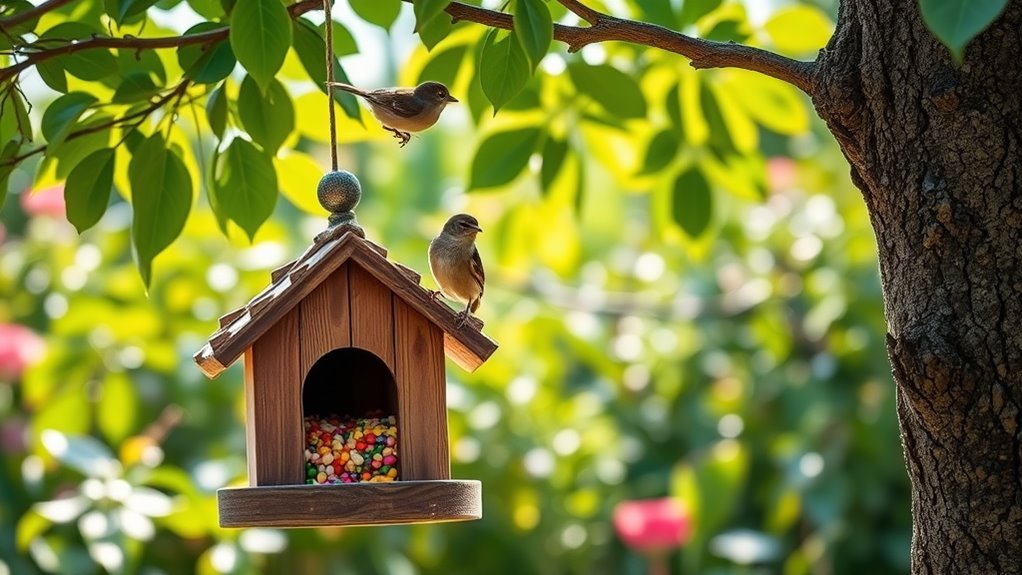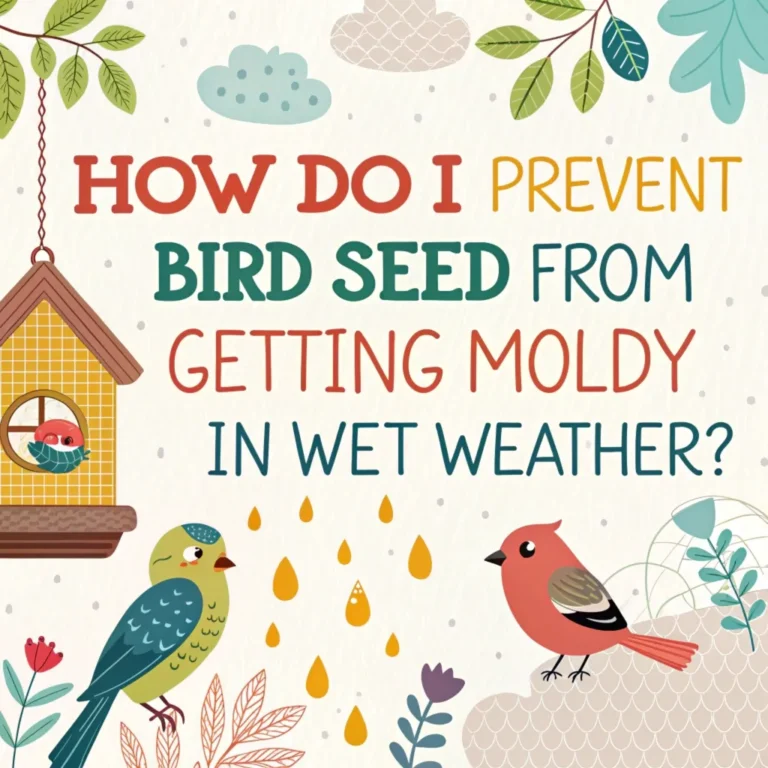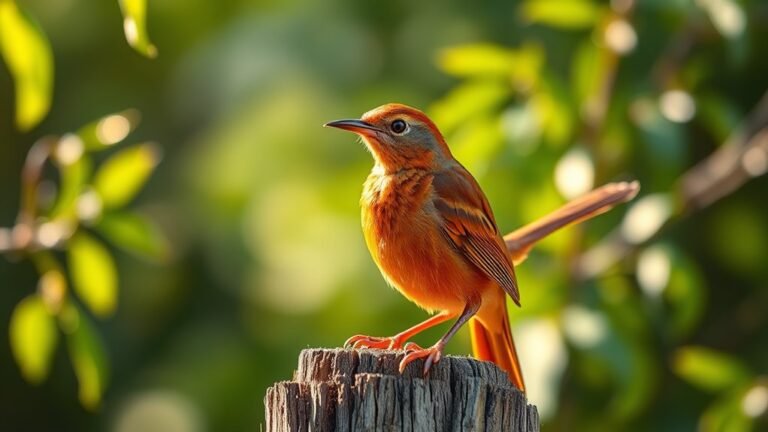Why Should Bird Nest Boxes Be Kept Away From Bird Feeders?
When setting up your backyard for birds, place nest boxes away from feeders. This helps reduce the risk of predators targeting vulnerable chicks and eggs. Keeping them apart lowers stress levels for nesting birds, which can improve their health and survival. Other factors that can influence their success include the availability of food, shelter, and safe nesting sites. By considering these elements, you can create a safer and more supportive environment for your backyard birds.
Key Takeaways
Keeping nest boxes away from bird feeders is important for several reasons:
- Reduce Predation Risks: Keeping a distance helps prevent predators from finding nesting sites. This reduces the chances of harm to young birds.
- Minimize Stress: A safe distance allows nesting birds to feel secure. This helps them focus on raising their young without distractions.
- Prevent Disease Transmission: Keeping feeders away from nest boxes lowers the risk of disease spreading among birds, creating a healthier environment.
- Encourage Natural Foraging: Increased distance promotes natural foraging behaviors in birds. This supports their instinctual activities and benefits the ecosystem.
- Enhance Nesting Success: Proper spacing provides safe locations for nesting and easier access to food. This improves the chances of successful nesting without the interference from nearby feeders.
In summary, maintaining a distance between nest boxes and bird feeders supports bird safety, health, and natural behaviors, ultimately leading to a thriving bird population.
Reducing Predation Risks
To reduce predation risks for birds using nest boxes and feeders, follow these simple steps.
First, place nest boxes away from dense vegetation to deter predators. Use natural barriers like shrubs or trees around the nesting area for added protection.
Position feeders at a safe distance from nest boxes to keep predators away.
Regularly check the area for signs of predation. This allows you to adjust your strategies as needed.
Minimizing Stress for Nesting Birds
Creating a safe environment for nesting birds is essential. Birds require a secure area to thrive. Stress can harm their ability to care for their young.
Placing feeders too close to nest boxes can attract other birds and predators. This makes the area feel unsafe. Increased stress can lead to less feeding and more vulnerability for the birds.
To help these birds, keep feeders at a safe distance from their nesting sites. A calm atmosphere allows them to focus on raising their young without interruptions.
Your actions help improve their nesting success and overall health.
Preventing Disease Transmission
Birds gather around feeders and nest boxes, making it important to prevent disease transmission in these areas.
When feeders are close to nesting spots, the risk of disease spreads among birds. Keeping a safe distance reduces the chance of birds transferring harmful germs while feeding and nesting.
This separation also helps control parasites, as birds feeding at feeders can introduce parasites to nests, putting vulnerable chicks at risk.
To protect your birds, ensure that feeders and nesting areas are spaced apart. This practice supports a healthier environment and a thriving bird community.
Your actions help keep these feathered friends safe and strong.
Encouraging Natural Behavior
Spacing feeders and nest boxes helps prevent disease and encourages natural bird behaviors.
Adequate distance allows birds to engage in instinctual activities, like foraging. When birds feel safe, they're more likely to search for food, which improves their survival skills.
Keeping feeders separate from nest boxes creates a calm environment where birds can explore and find food without distractions. This separation supports a healthier ecosystem, as birds can access food that resembles their natural habitats.
Encouraging these behaviors is essential for helping our feathered friends thrive, allowing you to enjoy their beauty and activity in your garden.
Enhancing Nesting Success Rates
To improve nesting success rates, provide birds with suitable habitats that meet their needs.
Focus on these key factors:
- Choose a sheltered box location: Select areas that protect birds from bad weather and predators.
- Ensure easy access: Place boxes close to food sources, but not right next to feeders.
- Offer plenty of nesting materials: Scatter natural items like twigs, grass, and feathers nearby to encourage nest building.
- Check box condition: Regularly inspect and clean the boxes to keep them usable for birds.
Frequently Asked Questions
How Far Should Bird Nest Boxes Be From Feeders?
Place bird nest boxes at least 10 to 30 feet away from feeders. This distance reduces disturbances during nesting. It allows birds to feed with less stress and focus on their natural behaviors. Keeping this space helps create a better environment for both feeding and nesting.
What Types of Birds Prefer Nesting Near Feeders?
Many songbirds prefer to nest near feeders. Chickadees and finches are common examples. These birds choose nesting locations close to feeders because they want easy access to food and protection from predators. This behavior helps them thrive in their environment.
Can Feeders Attract Predators to Nearby Nests?
Feeders can attract predators, which increases risks for nearby nests. Understanding how predators behave helps you create safer spaces for nesting birds. This ensures their safety while you enjoy the beauty of nature in your backyard. By taking simple steps, you can protect these birds and appreciate their presence even more.
Are There Specific Feeder Types That Increase Nest Box Risks?
Certain feeder designs, like platform feeders, can attract more birds. This increased activity may lead to more competition and stress during nesting. As a result, nearby nests may face a higher risk from predators, which can threaten the survival of young birds.
How Do Seasonal Changes Affect the Distance Between Feeders and Nest Boxes?
Seasonal changes affect how you should place feeders and nest boxes. During migration, birds often prefer feeders close to nest boxes. This closeness helps them find food easily. However, when nesting begins, increasing the distance between feeders and nest boxes is important. This distance helps reduce stress and competition among birds. A well-planned setup creates a peaceful environment for all birds.

Ava is a bird enthusiast and nature lover who has spent countless hours observing and learning about the fascinating world of birds. With a passion for sharing her knowledge and inspiring others to appreciate the beauty of birds, Ava writes about her experiences and insights on avianadmirer.com.







